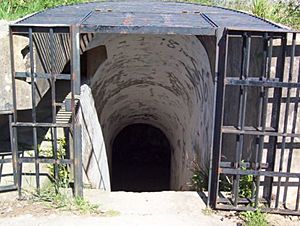Bilbao's Iron Ring facts for kids

The Bilbao Iron Ring (called Cinturón de Hierro in Spanish and Bilboko Burdin Hesia in Basque) was a special defense system built around the city of Bilbao in the Basque Country, Spain. It was quickly put together by the Basque Government during the Spanish Civil War. Its main goal was to protect Bilbao from the Nationalist army, which was moving closer to the city.
What Was the Iron Ring?
The Iron Ring was a huge network of defenses. It was like a giant maze of fortifications around Bilbao. This system included many bunkers, tunnels, and strong trenches. These defenses were set up in several layers, or "rings," and were protected by artillery guns.
However, even though it was very big, the Iron Ring used old ideas for defense. It was similar to the forts used in the First World War. This made it weak against newer weapons of the time. Modern aircraft (airplanes) and powerful artillery could easily attack it.
The defenses were also designed to hold a very large number of soldiers, about 70,000 troops. But in the end, only about 30,000 soldiers were there to defend it. This was less than half the number needed.
How Was It Defeated?
In February 1937, a very important event happened. The engineer who was in charge of building the Iron Ring, Alejandro Goicoechea, secretly joined the Nationalist side. He took all the plans and documents for the Iron Ring with him. This meant the Nationalist forces knew exactly where the defenses were and how they were built.
Because of this, the Iron Ring was easily broken through by the Nationalist army during the Battle of Bilbao. The attack started with a strong infantry (foot soldiers) assault. This was supported by heavy bombing from 150 artillery guns and 70 bomber planes. The entire defense system was defeated in just two days.
See also
 In Spanish: Cinturón de Hierro de Bilbao para niños
In Spanish: Cinturón de Hierro de Bilbao para niños

